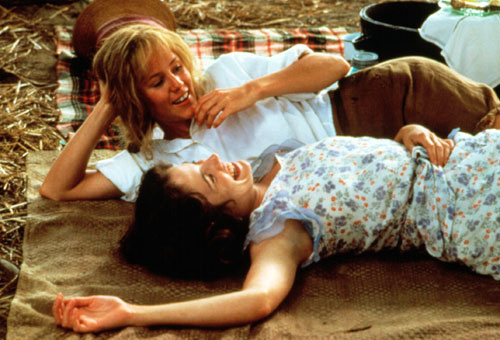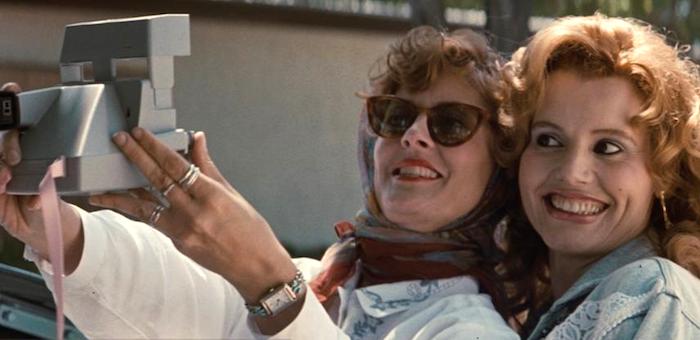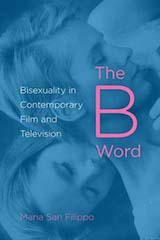You are here
The B Word: Bisexuality in Contemporary Film and Television – Excerpt
About the Author
Maria San Filippo is author of The B Word: Bisexuality in Contemporary Film and Television (Indiana University Press, 2013), a finalist for the Lambda Literary Award and Bisexual Book Award, and one of Slant’s top ten film studies books of 2013. She holds a Ph.D. in Cinema and Media Studies from UCLA, where she co-designed and taught the inaugural course on the Outfest UCLA Legacy Project Collection in conjunction with UCLA Film & Television Archive Research and Study Center. She has also taught at Harvard University, Indiana University, Bloomington, MIT, and at Wellesley College, where she was the 2008-2010 Mellon Postdoctoral Fellow in Cinema and Media Studies. Currently she is Assistant Professor and Director of the Film and Media Studies Program at University of the Arts in Philadelphia.

Fried Green Tomatoes (1991)
“For it is upon the repression of bisexuality that the organization of sexual difference, as enacted within our culture and as represented upon our cinema screens, is constructed.”
— Robin Wood, Hollywood from Vietnam to Reagan…and Beyond
Outside of the erotically transgressive realms of art cinema and pornography, screen as well as “real life” bisexuality is effaced not only by what I’ve named compulsory monosexuality but also by compulsory monogamy. For bisexuality, unlike heterosexuality and homosexuality, seems to rely on a temporal component for its (practical or conceptual) actualization. That is, at any given moment a bisexual person or film character might appear heterosexual or homosexual depending on his or her present object choice, a situation that significantly contributes to what I’ve been calling bisexual (in)visibility in society—even uncloseted bisexuals may feel as if they are leading a double life—and that challenges bisexual representation in film. Writing in 1996, Biddy Martin notes the way in which butch‑femme coupling contributes to lesbian mainstream visibility: “as a femme alone, her lesbianism would be invisible.”1 15 years later, we as a culture have grown increasingly accustomed to images of femme lesbians (indeed the butch is a far rarer species within screen media), but the assumption remains that the gender of one’s current object choice indicates one’s sexuality. The onus is thus regularly on bisexuality to “prove” itself—which seems to demand, for the individual bisexual, a roster of previous and current partners. Given that bisexuality is also thought to be a way station on the path to monosexual maturity, providing credentials for an identity deemed impermanent or nonexistent seems specious. Why, as Ed Cohen bluntly puts it, do we “make an identity out of whom we fuck?”2 Or, because many people’s sexual behaviors diverge from their identities, and because many others have sexual desires that remain unacted on, why do we make an identity out of the gender of (only) those with whom we pair publicly?
[B]ecause many people’s sexual behaviors diverge from their identities, and because many others have sexual desires that remain unacted on, why do we make an identity out of the gender of (only) those with whom we pair publicly?
Admittedly, the act of reading bisexually is often prompted by the undecidability of an image or instance in question—that is, textual resistance to pinning characters or narrative elements down as either straight or gay/lesbian in persuasion or perspective. This would seem to certify a given film’s bisexual/ity by who, or what, it is not, a strategy of definition through negation that might threaten to negate bisexuality itself. Yet, as Michael du Plessis urges, “we may well insist on our visibility by working through the conditions of our invisibility…We can begin naming ourselves and our various bisexual identities by, paradoxically, negation.”3 Without subscribing to the simplistic premise that more affirmative representations of bisexuality will cure bi‑phobia, it is hardly naïve to imagine, as critical bisexuality theory does, that “film’s images might have the power to break or smash ‘sacred’ images of sexuality, offering us other possibilities of intimacy—even if unnamed as such.”4
In UnInvited: Classical Hollywood Cinema and Lesbian Representability, Patricia White argues that the PCA mandate against implications of what it deemed “sex perversion” resulted in lesbianism’s manifestation on screen as a spectral presence, perceivable by “in the know” spectators but sufficiently opaque not to offend the mass audience that the PCA claimed to be protecting. Echoing Terry Castle’s apparitional trope for lesbian representation, White links the PCA’s conscious censorship to that of psychological censorship: the processes of disavowal summoned by the unconscious. Owing to its particular problems of legibility, bisexuality retains its slipperiness of signification even with newfound freedoms for sexual explicitness, maintaining its “legacy of absence” through spectral narrative connotation and spectatorial inference.5 But the continuing (in)visibility of screen bisexuality is also attributable to a cultural disavowal of bisexual desire, reinforced by the questions and meanings left unexplored by the specifically lesbian framework of studies such as White’s. Adopting White’s neologism "representability" signals my shift away from conceiving the textual images and instances under discussion here as (in)visible, towards an acknowledgement of their readability as bisexual.

Midnight Cowboy (1969)
Open‑ended conclusions, particularly those that leave unresolved the question of a character’s future object choices, compel us to regard individuals’ orientations and attractions as continually in flux. Much as we could not necessarily determine one’s sexual identity on the basis of one’s most recent partner, Marcy Jane Knopf suggests that to read bisexually necessitates moving beyond the typical inclination to read characters’ sexual orientations “based upon the desires or relationships at the end of a text—rather than looking at the fluctuations and variations of desire throughout the novel [or film].”6 Chapter 1 describes the ways in which art cinema’s characteristic ambiguity opens a space for bisexual representability. But paradoxically, textual resistance to or incapacity for monosexuality also are suggested by characters and texts that resolve the “conflict” of bisexual desire so tidily that they seem to protest too much. Post‑classical Hollywood films such as The Deer Hunter (Michael Cimino, 1978) and Top Gun (Tony Scott, 1986) make such excessive spectacle out of homoeroticism—in poignant scenes of wartime mourning in the former, and in the glisteningly virile displays of locker room and beach volleyball preening in the latter—so anxiously cast off the bisexual desire they have constructed in the course of the narrative that the “happily monosexual after all” conclusions often ring false or seem bewildering. This mode of resolution whereby monosexuality is re‑established attempts, though not terribly convincingly, to posit that bisexuality (as identity or practice) is unworkable as a long‑term option—a sentiment that can be found alongside affirmations of homosexuality, as we saw in Chasing Amy (Kevin Smith, 1997). In the steady spate of lesbian romantic comedies released in the last two decades—including When Night is Falling (Patricia Rozema, 1995) and Imagine Me & You (Ol Parker, 2005)—an initially heterosexual‑identified woman falls for a self‑assured lesbian and henceforth lays claim to a newfangled lesbian identity herself. Whether these stories of new love assert or challenge the idea of a universal monosexual destiny remains a vexed question.

The Color Purple (1985)
Hinging especially closely on the formation and sustenance of same‑sex bonds, the male buddy film and its counterpart the female friendship film offer up particularly potent sites of bisexual representability. Same‑sex couples such as Frodo (Elijah Wood) and Sam (Sean Astin) in Peter Jackson’s The Lord of the Rings trilogy (2001-2003) and Joe Buck (Jon Voight) and Ratso Rizzo (Dustin Hoffman) in Midnight Cowboy (John Schlesinger, 1969) are bi‑suggestive in giving, just as Alexander Doty notices about Gentlemen Prefer Blondes (Howard Hawks, 1953),“roughly equal emphasis to both same‑sex and opposite‑sex relationships, perhaps focusing somewhat more upon the importance of same‑sex intensities, which has the effect of challenging straight‑favoring cultural biases.”7 Depicting the largely unspoken, unacted upon desire between these screen couples encourages viewers to consider how these relationships would work differently if not governed by a monosexual logic of desire. Though the heterosexualization of female relationships in films such as that between Celie (Whoopi Goldberg) and Shug (Margaret Avery) in The Color Purple (Steven Spielberg, 1985) and between Idgie (Mary Stuart Masterson) and Ruth (Mary-Louise Parker) in Fried Green Tomatoes (Jon Avnet, 1991) may seem similarly monosexist, these films often make oblique reference to consummation (in whatever form) having taken place, in so doing complicating our reading of specific characters’ sexualities. Even when (as in the cases of these novel‑to‑film adaptations) such implications are erased or obscured for narrative purposes or straight viewers’ comfort, we should not be too hasty to rule out the potential for a bisexual reading. To do so would be to fall prey to the heterosexist fallacy of “straight until proven otherwise,” which stems from a systemic logic of desire in which the (homo)erotic and the “merely” (homo)social are sharply divided. Even in the relatively permissive post‑Production Code cinema that is my focus, “proof” of bisexuality depends on behaviors that a character is hard‑pressed to demonstrate within the confines of a feature‑length film, in which not just running time but narrative circumstances can foreclose the development of a character’s bisexual potential. The heroines of Thelma and Louise (Ridley Scott, 1991), to take another instance from the female “friendship” canon, would presumably have found occasion to explore their burgeoning attraction had they not been on the run from the law; as it is, they have only enough time for a quick kiss before speeding over the Grand Canyon’s rim. The serial format of television drama makes it the medium with the most bi‑potential in this regard, as its (multi‑)seasonal arcs allow time for bisexuality to develop. The extent to which that potential is realized is the focus of the final chapter of my book.

Thelma and Louise (1991)
Given these accumulated roadblocks to defining and representing bisexuality, alongside the eclipsing of bisexual activism and political visibility, it makes sense that bisexual readings of cultural texts have benefited little from the considerable energies devoted in recent times to queer appropriation and canonization. Attempting to compensate for the dearth of explicitly LGBT images, queer film criticism focused for a time on revealing sub‑textual or sub‑cultural meanings in ostensibly “straight” narratives. “The pleasures of such readings are simple,” writes Paul Burston: “what better revenge on a culture that seeks to exclude you than to demonstrate how you were there all along?”8 This reading “against the grain” risks re‑inscribing queerness within the shadowy realm of connotation—the textual closet, so to speak—without dispelling the presumption of the text’s inherent straightness. “It implies taking a thing that is straight and doing something to it,” Doty observes, proposing instead that we view “queer discourses and practices as being less about co‑opting and ‘making’ things queer…and more about discussing how things are, or might be understood as, queer.”9 Following Doty, I am most interested in defamiliarizing images and expressions of desire assumed to be monosexual, and in examining the processes of signification and subjectification whereby representations of bisexuality are constructed yet made (in)visible. Ultimately, I aim to gauge how screen bisexuality “looks” over time, bisexuality’s relation to other identity constructions, and the meanings these hold for understanding our logic of desire. These spaces of queerness, fluidity, and liminality indicate the extent to which screen media serve as a singular cultural forum for imagining and negotiating desire of many stripes.
Download a PDF of this excerpt.
Book excerpt reproduced with the permission of the author. The B Word: Bisexuality in Contemporary Film and Television was published in 2013 by Indiana University Press.
Notes
1. Biddy Martin, Femininity Played Straight: The Significance of Being Lesbian (New York: Routledge, 1996), 86.
2. Ed Cohen, “Are We (Not) What We Are Becoming?: ‘Gay,’ ‘Identity,’ ‘Gay Studies,’ and the Disciplining of Knowledge,” in Engendering Men: The Question of Male Feminist Criticism, ed. Joseph A. Boone and Michael Cadden (New York: Routledge, 1988), 174.
3. Michael du Plessis, “Blatantly Bisexual; or, Unthinking Queer Theory,” in RePresenting Bisexualities: Subjects and Cultures of Fluid Desire, ed. Donald E. Hall and Maria Pramaggiore (New York: New York University Press, 1996), 20-1.
4. Karen Yescavage and Jonathan Alexander, “Seeing What We Want to See: Searching for Bisexual Representation in ‘Threesome’ Films,” Journal of Bisexuality, 3.2 (2003): 125.
5. Patricia White, UnInvited: Classical Hollywood Cinema and Lesbian Representability (Bloomington: Indiana University Press, 1990), 1. See Terry Castle, The Apparitional Lesbian: Female Homosexuality and Modern Culture, New York: Columbia University Press, 1993.
6. Marcy Jane Knopf, “Bi-nary Bi-sexuality: Jane Bowles’s Two Serious Ladies,” in RePresenting Bisexualities: Subjects and Cultures of Fluid Desire, ed. Donald E. Hall and Maria Pramaggiore (New York: New York University Press, 1996), 157.
7. Alexander Doty, “Queer Theory,” in Film Studies: Critical Approaches, John Hill and Pamela Church Gibson, ed. (New York: Oxford University Press, 2000), 132.
8. Paul Burston, “Just a Gigolo? Narcissism, Nellyism, and the ‘New Man’ Theme,” in A Queer Romance: Lesbians, Gay Men and Popular Culture, ed. Paul Burston and Colin Richardson (New York: Routledge, 1995), 120.
9. Alexander Doty, Flaming Classics: Queering the Film Canon (New York: Routledge, 2000), 2.
To report problems, broken links, or comment on the website, please contact support
Copyright © 2025 UCLA Film & Television Archive. All Rights Reserved






 Mobile Navigation
Mobile Navigation


